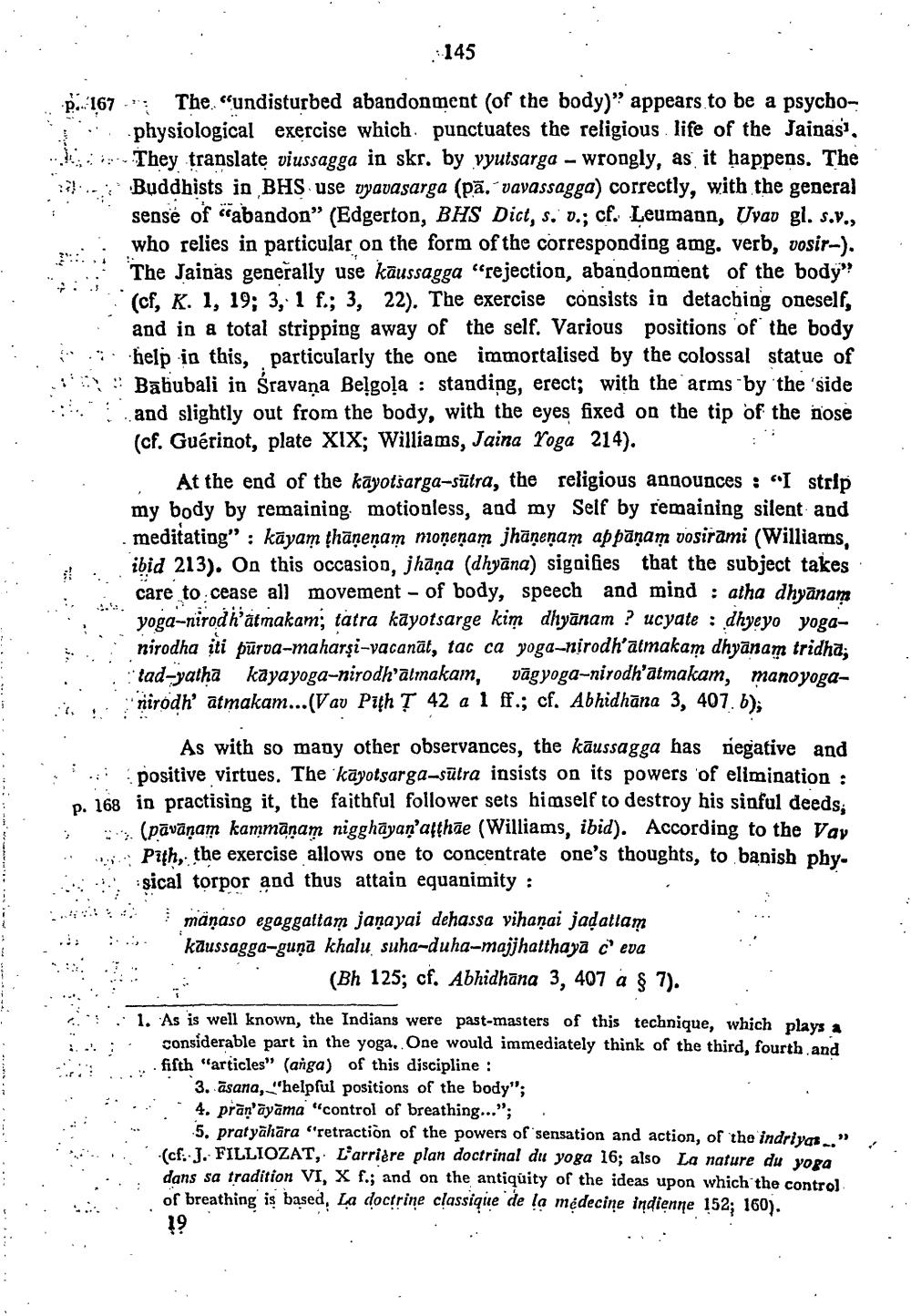________________
145
:
P167 The "undisturbed abandonment (of the body)" appears to be a psycho
physiological exercise which. punctuates the religious life of the Jainas'.
They translate viussagga in skr. by yyutsarga - wrongly, as it happens. The zl... Buddhists in BHS use vyavasarga (pā, vavassagga) correctly, with the general
sense of "abandon” (Edgerton, BHS Dict, s.' v.; cf. Leumann, Uvav gl. s.v., who relies in particular on the form of the corresponding amg. verb, vosir-).
The Jainas generally use kaussagga "rejection, abandonment of the body"! ; (cf, K. 1, 19; 3, 1 f.; 3, 22). The exercise consists in detaching oneself,
and in a total stripping away of the self. Various positions of the body , held in this particularly the one immortalised by the colossal statue of : Babubali in Śravana Belgola : standing, erect; with the arms by the side
and slightly out from the body, with the eyes fixed on the tip of the nose (cf. Guérinot, plate XIX; Williams, Jaina Yoga 214).
At the end of the kāyotšarga-sūtra, the religious announces : "I strip my body by remaining motionless, and my Self by remaining silent and tating" : kāyam thānenam moņeņam jhāņeņam appānam vosirami (Williams,
. On this occasion, jhana (dhyāna) sigaifies that the subject takes care to cease all movement - of body, speech and mind : atha dhyānam yoga-nirodh'atmakam; tatra kayotsarge kim dhyānam ? ucyate : dhyeyo yoganirodha iti pūrva-maharşi-vacanāt, tac ca yoga-nirodh'atmakam dhyanam tridha:
tad-yatha kayayoga-nirodh'almakam, vāgyoga-nirodh'atmakam, manoyoga. nirodh' atmakam... (Vav Pith Ţ 42 a 1 ff.; cf. Abhidhāna 3, 407.6);
i
As with so many other observances, the kāussagga has negative and . positive virtues. The kāyotsarga-sūtra insists on its powers of elimination : p. 168 in practising it, the faithful follower sets himself to destroy his sinful deeds: ; (pāvāņam kammāņam nigghāyaṇ'atthae (Williams, ibid). According to the Vay
Puh, the exercise allows one to concentrate one's thoughts, to banish phy.
sical torpor and thus attain equanimity : ***. mäņaso egoggattam janayai dehassa vihanai jadatlam . .s kaussagga-guna khalu suha-duha-majjhatthaya ceva
(Bh 125; cf. Abhidhāna 3, 407 a § 7).
ei
- 14
.
1. As is well known, the Indians were past-masters of this technique, which plays a
considerable part in the yoga. One would immediately think of the third, fourth and fifth "articles" (anga) of this discipline :
3. āsana, "helpful positions of the body''; .. 4. prānāyāma "control of breathing..."; .
5. pratyālāra "retraction of the powers of sensation and action, of the indriyas..." (cf. J. FILLIOZAT, L'arrière plan doctrinal du yoga 16; also La nature du yoga dans sa tradition VI, X f.; and on the antiquity of the ideas upon which the control of breathing is based, La doctrine classique de la médecine indienne 152; 160). 19
-
Hm...
...




